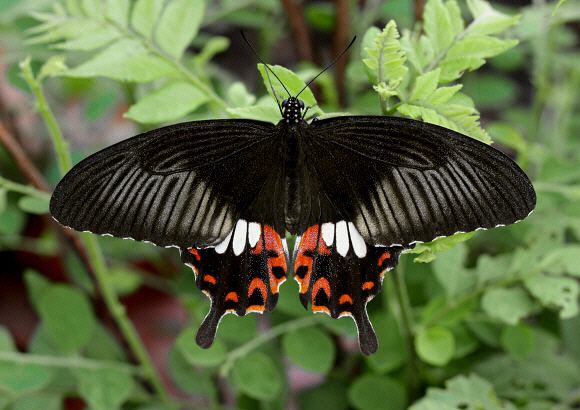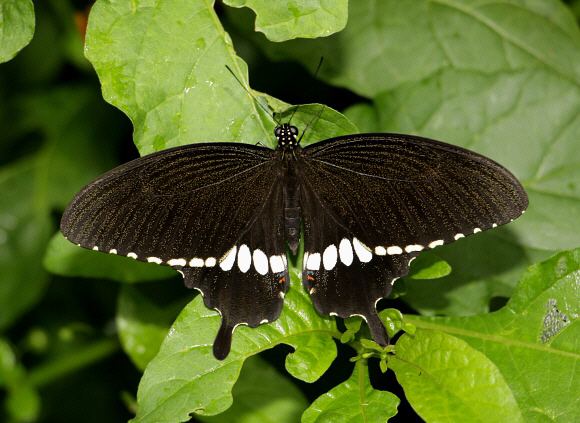Genus Papilio Higher classification Papilio | Scientific name Papilio polytes Rank Species | |
 | ||
Similar butterfly, swallowtail butterfly, Papilio, Pachliopta aristolochiae, Papilio memnon | ||
Common mormon papilio polytes larva preparing to its pupate
Papilio polytes, the common Mormon, is a common species of swallowtail butterfly widely distributed across Asia.
Contents
- Common mormon papilio polytes larva preparing to its pupate
- Papilio polytes romulus
- Names
- Range
- Status
- Description
- Male
- Female
- Gynandromorphs
- Taxonomy
- Mimicry
- Habitat
- Habits
- Eggs
- Caterpillar
- Pupa
- Food plants
- References
This butterfly is known for the mimicry displayed by the numerous forms of its females which mimic inedible red-bodied swallowtails, such as the common rose and the crimson rose.

Papilio polytes romulus
Names

The common name is an allusion to the polygamy formerly practiced by members of the Mormon sect according to Harish Gaonkar, of the Natural History Museum in London:

... the origins of giving common English names to organisms, particularly butterflies for tropical species started in India around the mid 19th century ... The naming of Mormons evolved slowly. I think the first to get such a name was the Common Mormon (Papilio polytes), because it had three different females, a fact that could only have been observed in the field, and this they did in India. The name obviously reflected the ... Mormon sect in America, which as we know, practiced polygamy.
The scientific name is constructed from the Latin word for butterfly, papilio, and the Greek word for many, poly.
Range
Pakistan, India, Bangladesh, Nepal, Sri Lanka, Maldives, Myanmar, Thailand, southern and western China (including Hainan and Guangdong provinces), Taiwan, Hong Kong, Japan (Ryukyu Islands), Vietnam, Laos, Cambodia, Andamans, Nicobars, Eastern and Peninsular Malaysia, Brunei, Indonesia (except Moluccas and Irian Jaya), Philippines, and Northern Marianas (Saipan).
Status
Very common. Not threatened.
Description
Jet black butterfly with row of white spots along the middle part of hindwing. 90–100 mm.
Male
The male has one morph only. It is a dark-coloured swallow-tailed butterfly. The upper forewing has a series of white spots decreasing in size towards the apex. The upper hindwing has a complete discal band of elongated white spots. It may or may not have marginal red crescents. The males are generally smaller in size than the females but not always. Both male and all forms of the female of P. polytes can vary considerably in size depending on climatic region.
Female
The female of the common Mormon is polymorphic. In the Indian Subcontinent, it has three forms or morphs. These are as follows:
Form cyrus
This form is similar to the male, differing in that it always has strongly marked red crescents. It is the least common of the three forms. It is normally abundant where the common rose or crimson rose do not occur, such as in Himachal Pradesh around Shimla; although a few specimens of form romulus have also been caught alongside.
Form stichius
This female form of the common Mormon mimics the common rose very closely. This is the commonest form wherever the common rose flies.
Form romulus
This female form mimics the crimson rose and is common over its range. It is not such a close mimic as the previous form being duller than its model. It is easy to differentiate the mimics from models by the colour of their body—the models are red-bodied and the mimics are black-bodied.
Gynandromorphs
This species has considerable genetic variability and is known to produce gynandromorphs, genetic aberrations which are part male and part female.
Taxonomy
Papilio polytes is the nominal member of the polytes species group. The clade members are:
The subspecies of Papilio polytes listed alphabetically are:
Mimicry
In India, this butterfly is considered as the classic example of Batesian mimicry in which edible species resemble unpalatable butterflies in order to escape being eaten by predators.
The populations of the mimicking morphs of the common Mormon are much smaller than that of their models - the common or crimson rose. This is in order to allow first time predators a much greater chance of preying upon the unpalatable model in the first instance and thus learning of their inedibility.
Larger populations of mimics could result in the edible common Mormon mimics being sampled the first time by predators. If this should happen, the predator may not realise that butterflies of that colour and pattern are protected by the poisons they ingest; thus dramatically reducing the effectiveness of this scheme of protection.
In Sulawesi, although the common rose is abundant, the common Mormon female morph which is found there, mimics a completely different butterfly, Atrophaneura polyphontes.
Habitat
The common Mormon prefers lightly wooded country, but is present everywhere and high up into the hills. It is a regular visitor to gardens, being especially abundant in orchards of its food plants—oranges and limes. It is most common in the monsoon and post-monsoon months.
Habits
The common Mormon is fond of visiting flowers and its long proboscis permits it to feed from flowers having long corollar tubes. It is particularly fond of Lantana, Jatropha, Ixora, and Mussaenda in city gardens. In the forests, the common Mormon remains low keeping within ten feet off the floor and its prefer to visit Asystasia, Peristrophe, and Jasminum for nectar.
The male common Mormon is a very common visitor to gardens where he will be seen hovering over flowers when the sun is shining. It is a restless insect, zig-zagging fast and straight close to the ground, settling down only when it halts to feed.
The mimic female Mormons, stichius and romulus are very convincing mimics due to their habits, especially the flight patterns, being very similar to those of the rose models. However, lacking the protection of inedibility, they tend to be more easily disturbed than the roses and fly off erratically .
Only the males take part in mud puddling, usually in cool shaded spots rather than in open areas. They have been known to collect on saline soils to extract minerals.
Both sexes bask in the sun on shrubs close to the ground. They hold their wings flat against the substratum. The forewing is lowered to cover part of the hindwing and is a typical stance of the common Mormon.
Common Mormons spend the night settled on vegetation with their wings held open, usually quite close to the ground.
The females perch on an exposed branch with wings open or closed. They are courted by the males who approach from behind and slowly and elegantly settle into position.
Eggs
The eggs are laid singly on top of the leaves. They are round and yellow to light-orange in colour.
Caterpillar
The first few instars of the caterpillar closely resemble those of the lime butterfly.
The later instars become dark green in colour. There is a transverse black band with an eye-spot on each side on the 4th and 5th segments. This band, being darker and brighter than that of the lime butterfly caterpillar, is the key distinction between the two.
The common Mormon caterpillar also has a black and white oblique band on the 8th and 9th segments, making it resemble that of the blue Mormon. The deep red osmeterium and yellowish-brown head help distinguish it from the blue Mormon caterpillar which has a greenish head.
Common Mormon caterpillars are heavily parasitised by chalcid wasps, with over a hundred tiny wasps eventually emerging from each Mormon pupa.
Pupa
The pupa is located on underside of leaves and twigs. The pupa is light green and unmarked. It has two projections to the front on its head and also one on its thorax. It closely resembles the lime butterfly caterpillar but can be distinguished by:
Food plants
The larvae breed on various species of family Rutaceae including:
